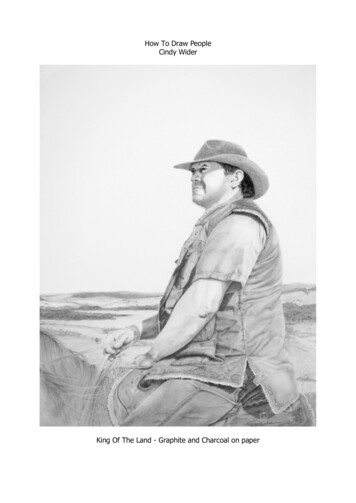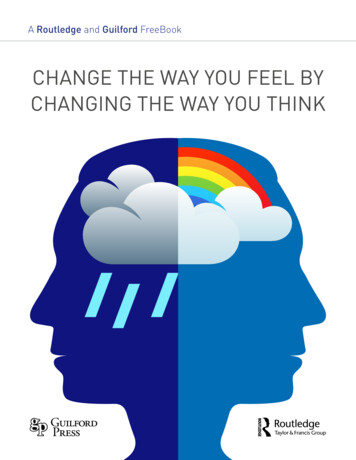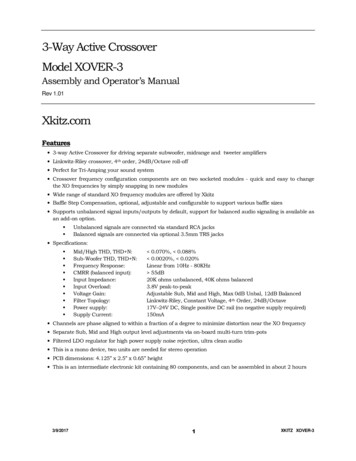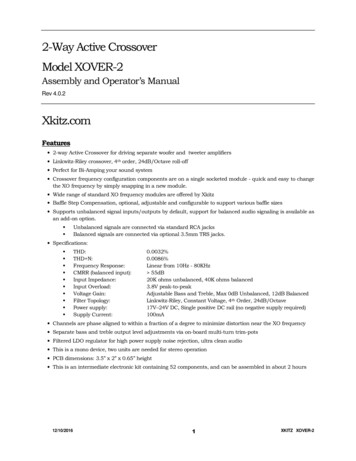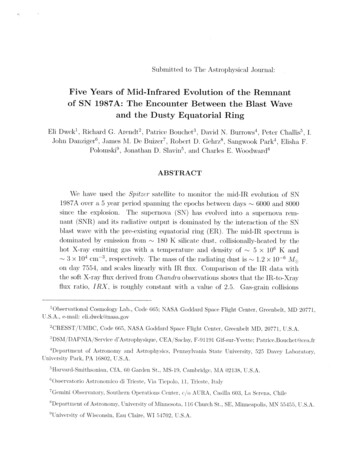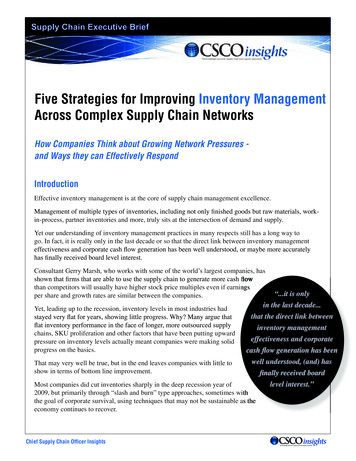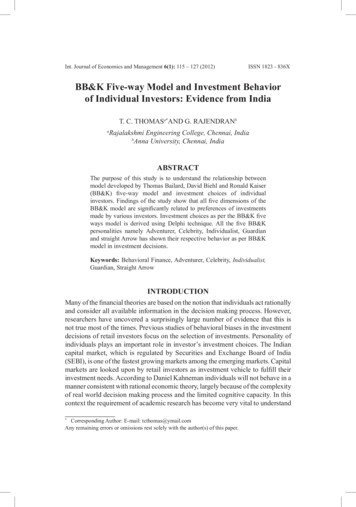
Transcription
Int. Journal of Economics and Management 6(1): 115 – 127 (2012)ISSN 1823 - 836XBB&K Five-way Model and Investment Behaviorof Individual Investors: Evidence from IndiaT. C. THOMASa*AND G. RAJENDRANbaRajalakshmi Engineering College, Chennai, IndiabAnna University, Chennai, IndiaAbstractThe purpose of this study is to understand the relationship betweenmodel developed by Thomas Bailard, David Biehl and Ronald Kaiser(BB&K) five-way model and investment choices of individualinvestors. Findings of the study show that all five dimensions of theBB&K model are significantly related to preferences of investmentsmade by various investors. Investment choices as per the BB&K fiveways model is derived using Delphi technique. All the five BB&Kpersonalities namely Adventurer, Celebrity, Individualist, Guardianand straight Arrow has shown their respective behavior as per BB&Kmodel in investment decisions.Keywords: Behavioral Finance, Adventurer, Celebrity, Individualist,Guardian, Straight ArrowIntroductionMany of the financial theories are based on the notion that individuals act rationallyand consider all available information in the decision making process. However,researchers have uncovered a surprisingly large number of evidence that this isnot true most of the times. Previous studies of behavioral biases in the investmentdecisions of retail investors focus on the selection of investments. Personality ofindividuals plays an important role in investor’s investment choices. The Indiancapital market, which is regulated by Securities and Exchange Board of India(SEBI), is one of the fastest growing markets among the emerging markets. Capitalmarkets are looked upon by retail investors as investment vehicle to fulfill theirinvestment needs. According to Daniel Kahneman individuals will not behave in amanner consistent with rational economic theory, largely because of the complexityof real world decision making process and the limited cognitive capacity. In thiscontext the requirement of academic research has become very vital to understand*Corresponding Author: E-mail: tcthomas@ymail.comAny remaining errors or omissions rest solely with the author(s) of this paper.
International Journal of Economics and Managementthe complexity of investments on the basis of investor’s personalities. Researchersacross the past several decades have analyzed the behavior of investors and madean attempt to enhance our understanding of why investors manage investmentsin different ways. BB&K Five Investor Personality types developed by ThomasBailard, David Biehl and Ronald Kaiser classify investor personalities along twoaxes-level of confidence and method of action.Literature reviewReview of Literature shows that how retail investor’s personal characteristicsinfluence their various investment choices. If a common theme is present in thisliterature, it is that personal characteristics influence investors’ perception of riskand their willingness to assume risks. In turn the perception of risk determinesinvestment behavior of retail investors. However, a prevailing question leftunanswered is the extent to which individual’s personal characteristics influencetheir intentions about investing. The expected utility approach of Von Neumannand Morgenstern (1947) has provided the foundation for the primary view of riskin economics and finance for many years. The main concept in their model isthat the maximization of expected utility is the sole factor in making decisions.Markowitz (1952) proposes a two-criterion approach when an investor is facedwith the desire for higher returns but not wanting the uncertainty of returns, whichinvestor perceives as risk. The literature has developed into two schools of thoughtas researchers have sought to explain the choices investors make about risk withintheir investments. One group of scholars has used demographic features that relatethe significance of gender, ethnicity, wealth, income, age and variety of other factorsto the explanation of investment management decisions. The other group has itsfoundations in psychology, using investors’ psychological characteristics to explainchoices that are made concerning investment decisions.Although an interesting array of demographic characteristics have been used toexplain what drives the investment behavior of individuals, the discussion continuesin the literature concerning the psychological antecedents that would accompany thishuman behavior. A variety of studies have attempted to explore the psychologicalexplanations for investor behavior. In the demographic studies, the implicationsof gender are mostly perceived by various researchers are key in explaining thebehavior of investors. Barber and Odean (2001), Hallahan, Faff and McKenzie(2004), Bajtelsmit and Bernasek (1996), Worthington (2006), Felton, Gibson andSanbonmatsu (2003), Bajtelsmit, Bernasek and Jinakoplos (1999), Hariharan,Chapman and Domian (2000) and Oslen and Cox (2001) have concluded that genderplays a key role in risk aversion. Filbeck, Hatfield and Horvath (2005) used theMyers-Briggs Type Indicator to assess risk tolerance differences between peoplewith different personality characteristics. From the discrete personality groupingsin the Myers-Briggs, the researchers are able to establish behavioral linkages to116
BB&K Five-way Model and Investment Behavior of Individual Investors: Evidence from Indiarisk tolerance of individual investors. Their findings confirm that personality typedoes explain some aspects of investment behavior. Read and Loewenstein (1995)studied diversification bias in the context of consumer choices. French and Poterba(1991) estimate the domestic ownership share of the world’s five largest stockmarkets in 1990: US 92.2%, Japan 95.7% and Germany 79%. Goetzmann andKumar (2001) examine the diversification of investors with respect to demographicvariables of age, income and employment. Kahneman D and Riepe M.W (1998)focus on biases in beliefs & preferences of which financial intermediaries shouldbe aware and provide recommendations on how to avoid them or mitigate theirharmful effects of biases. Keller C and Siegrist M (2006) analysed the influence offinancial risk attitude and values-related money and stock market attitudes. OdeanT (1998) identified that a particular class of investors sell winners more readilythan losers. This is in spite of alternative rational motivations are controlled forthese investors continue to prefer selling winners and holding losers. Shiller R.J.emphasized the very importance of conversation in the contagion of popular ideasabout financial markets. Shefrin (2000) in the ‘Beyond Greed and Fear’ explainedthe Psychology of individual investors. Lo et al. (2005) explained that the lack ofcorrelation between trading performance and personality traits. Goldberg and VonNitzch (2001) explained a personal experience of a day trader who goes throughmany emotional stages during various stages like profits and losses OWCAREFULGuardianIMPETUOUSCelebrityANXIOUSSource: Thomas Bailard, David Biehl and Ronald Kaiser, Personal Money Management, 5th ed. (Chicago: ScienceResearch Associates, 1986)Figure 1117
International Journal of Economics and ManagementThomas Bailard, David Biehl and Ronald Kaiser developed a model calledBB&K Five-Way model features the classifying investor personalities along twoaxes- level of confidence and method of action-it introduces an additional dimensionof analysis. Thomas Bailard, David Biehl and Ronald Kaiser provided graphicreorientations of their model and this model classified investor personalities alongtwo axes: level of confidence in vertical axis and method of action in horizontal axis.The first sub classification that the model incorporates deals with how confidentlyan investor approaches life in general-including issues unrelated to money. Whennegotiating a wide variety of life choices, are individuals rigidly self-assured, or dothey suffer from misgivings and anxiety? The second element of the BB&K modelasks whether investors are methodical, careful and analytical in their approach tolife or whether they are emotional, intuitive and impetuous. These two elements canbe thought of as two axes of individual psychology: one axis is called “confidentanxious”, and other is called “careful-impetuous”.Following are the descriptions of the BB&K investor personalities:The Adventurer: People who are willing to put it all on one bet and go for itbecause they have confidence. They are difficult to advice, because they have theirown ideas about investing. They are willing to take risks, and they are volatileclients from an investment counsel point of view.The Celebrity: These people like to be where the action is. They are afraid ofbeing left out. They really do not have their own ideas about investments. Theymay have their own ideas about other things in life, but not investing. As a resultthey are the best prey for maximum broker turnover.The Individualist: These people tend to go their own tend to go their own wayand are typified by the small business person or independent professionals suchas lawyer, engineer or CAs. These are people who are trying to make their owndecisions in life, carefully going about things, having a certain degree of confidenceabout them, but also being careful, methodical and analytical. These are clientswhom everyone is looking for-rational investors with whom the portfolio managercan talk sense.The Guardian: Typically as people get older and begin considering retirement,they approach this personality profile. They are careful and a little bit worried abouttheir money. They recognize that they face a limited earning time span and have topreserve their assets. They are definitely not interested in volatility or excitement.Guardians lack confidence in their ability to forecast the future or to understandwhere to put money, so they look for guidance.118
BB&K Five-way Model and Investment Behavior of Individual Investors: Evidence from IndiaThe Straight Arrow: These people are so well balanced; they cannot be placedin any specific quadrant, so they fall near the center. On average this group ofclients is the average investor, relatively balanced composite of each of the otherfour investor types, and by implication a group willing to be exposed to mediumamount of risk.In the view of literature review, the present study undertakes two tasks.First undertake the examination of behavioral intentions as related to personalinvestment and portfolio management. If behavioral intentions are good predictorsof actual behavior and these intentions can be changed by the formation ofattitudes, subjective norms, and perceptions of self-control, then they should beamenable to interventions from financial counselors. Thus, identifying the natureof a behavioral intention with respect to personal finance is important. Second,given the paucity of literature examining risk perceptions and personality factorsas predictors of intentions, set out to examine prominent predictors of intentions,specifically with personal finance in mind. Behavioral intentions have been thetopic of a large quantity of social and behavioral science research over the past 35years. Behavioral intentions are hypothesized to be influenced by attitudes towarda given behavior, subjective norms, and a perceived sense of behavioral control.This theory contends that behavioral intentions are highly predictive of behavior.The investor behavior is dynamic and it changes according to various extraneousfactors. Literature review also tells that normally investors are irrational and mostof the time their investment behavior is subject to various behavioral biases. Tounderstand the pattern of investment behavior no study was conducted in India totest the relationship between BB&K model and investment behaviors. So a gap inthe review of literature was found, to fulfill this gap this study was conducted tounderstand the relationship between BB&K model and investment pattern in India.MethodologyThis study is made of two sections; the first one is constructing hypothesizedinvestment choices using the Delphi method through which hypothesizedinvestment choices among various investors are identified. In the second section,primary data was collected through questionnaire in Chennai city, India tounderstand the relationship between type of investments choice and BB&K fiveway personality types.Delphi MethodThe expert panel was identified from various organizations including financialintermediaries. In this process BB&K five–way model and various investmentavenues have been subjected to Delphi method and following investment pattern119
International Journal of Economics and Managementis evolved with related to BB&K Five Investor Personality types. The DelphiTechnique was considered to be useful to structure the in-depth interviews withexperts on the investor personality types and investment choices. This methodis typically used to achieve expert-judgment on questions about the future, andespecially when a great deal of uncertainty and complexity surrounds the researchproblem. The Delphi technique is therefore very fitting to find answers to theresearch questions of this paper. The method operates on the principle that expertson a subject, together, will make conjectures based upon rational judgment. The aimis to gather viewpoints from several experts, and to either achieve a consensus or alist of reasons or arguments for why the experts hold different views. Each expert isinterviewed individually to maintain anonymity and to avoid the bias of dominantindividuals. In this sense the technique helps structure the group communication.There are many advantages of the technique as well, when the groups ofcontributing experts has no underlying organizational ties and represent a diversepopulation with respect to background, experience, expertise, and location
the Adventurer: People who are willing to put it all on one bet and go for it because they have confidence. They are difficult to advice, because they have their own ideas about investing. They are willing to take risks, and they are volatile clients from an investment counsel point of view.

